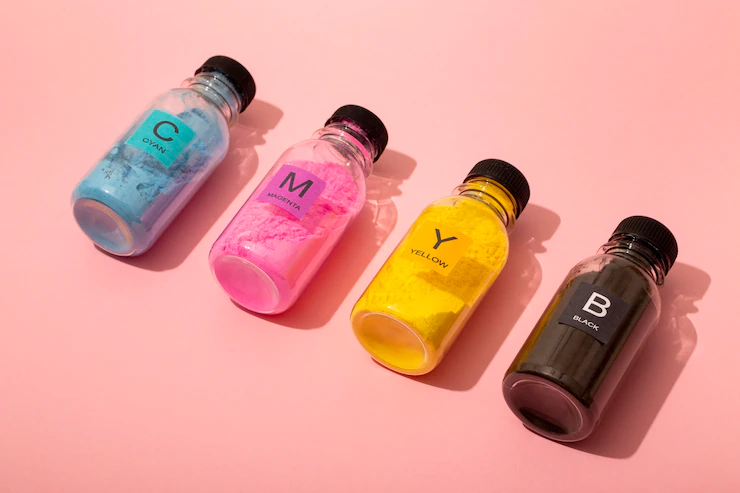A particular strength of inkjet printing technology is its versatility. There is a wide variety of inks, with dyes or pigments, that can be printed on a wide range of substrates: plain and coated papers, cardstock, film, canvas, vinyl, fabric, leather and more. High-gloss inks and print media have a much higher color brilliance and ensure more beautiful images. Inks for high-gloss printing are often UV-sensitive and fade after a short time. The heat generated by the lighting can also adversely change and fade the colors on the displays. The following subdivision is problematic, since inks can be classified both according to their field of application and their composition. Because of the different printing system, certain printers are suitable for either dye or pigmented inks. The requirements for the papers are also different. For best results, there are papers for dye inks and for pigmented inks.
Dye inks
Dye inks are based on dissolved dyes. Therefore, these inks are not waterproof. They should penetrate the paper without running sideways. There are variants with increased light resistance, which are particularly suitable for high-quality image printing. The color space of the dye-based inks is large. Printed on the appropriate media, the result is almost a photo-realistic impression. Dye inks are used almost exclusively indoors (“indoor” inks).
Pigment inks
For outdoor applications, pigment inks are used almost exclusively, which are characterized by high UV resistance and water resistance. These inks adhere to the surface of the paper or penetrate only a little. For short-term outdoor use, lamination can be dispensed with. Special combinations of ink, medium and laminate result in durability of several years. The color space of pigment inks is slightly narrower than that of dye inks. Paper with a gloss finish can have a dull gloss finish if the total ink coverage is very high.
There are companies that coat the pigment particles with a special resin. When they hit the print medium, they are fixed by polymerisation. The harmonized shape and size of the particles and the film of polymerized resin are said to reduce light scattering and thus improve image quality. These inks have properties that distinguish them from liquid inks. The printheads are similar, but the inks are solid at room temperature. They are first melted and the hot droplets are mostly ejected through piezo transducers. When they hit the carrier, they solidify immediately. Since no water has to dry on the substrate, printing can be carried out faster than with liquid inks.
Wax inks
Wax inks are less dependent on the substrate than liquid inks. They hardly penetrate the medium. Similar to thermal transfer printing, the color dots are therefore on the surface, but they are usually much smaller and deliver better image quality, which at best comes close to that of liquid ink printers. The wax dots are additionally fixed with a post-print treatment. Pigments or dyes are used as colorants. Light stability is similar to traditional ink materials, but as with thermal transfer printing, images are sensitive to scratches and surface damage, and will bleed under the influence of higher temperatures.
Reactive and sublimation inks
Choosing the right ink is crucial for textile printing. With the systems offered, a distinction is made between reactive and sublimation inks. Reactive ink is used when printing on natural fibers (e.g. cotton). The material must be pre-treated for this, otherwise the colors will fade. Mixed fibers (e.g. silk or linen fabric) are printed with acidified inks. These combine with the fiber of the fabric and can be fixed with hot steam. When printing on synthetic fibers (e.g. T-shirts), emulsion paints are used that have to be heat-fixed. The process fuses the ink to the fiber. With the sublimation inks, the printing is usually done on a transfer paper. The color migrates from the paper into the fabric under a heating press and is fixed.
Pinkstix
The company Tektronix, which was bought by Xerox, developed solid ink printers that look like a color laser and also work at least as fast. These solid ink printers, such as the Xerox Phaser 860, are filled with Inkstix, which look like oversized gummy bears, instead of ink. The inside of the inkjet printer melts this waxy inkstix . The printer then sprays the liquefied ink onto the paper using piezo nozzles. The advantage of this is that the print head is not moved back and forth across the paper width as with ink printers, but occupies the entire paper width and can therefore print very quickly and quietly. However, these Phaser printers are only worthwhile if there is a lot of printing, because the printing device should always remain switched on, since the printer takes at least 20 minutes to become operational. In addition, the inkjet printer consumes quite a lot of ink during the melting process after it is switched on. On the other hand, if the printer is always switched on, it consumes a lot of electricity, but it is immediately ready to print.
German Ink
German ink is a special form of ink that is characterized by a very strong color and often contains a binder. Black ink is generally made from carbon black, which is finely dispersed in colloidal solutions of (saponified) shellac and binders (e.g., gum Arabic, glue). In the case of the color contrast black, inks differ from German inks in that they are not pigmented. Some inkjet printers have a second black cartridge with pigmented black, which allows for optical density equivalent to that of a laser printer on plain paper. However, since this black is not suitable for photo printing, a second black cartridge is used. There are also inkjet printers that work exclusively with pigmented ink.




